
Mike K
-
Posts
583 -
Joined
-
Last visited
Content Type
Profiles
Forums
Blogs
Gallery
Events
Store
Posts posted by Mike K
-
-
Hi Dan,
The unit may actually be the AOK6 (not b?) but I'm not up on Imperial Army abbreviations.
I have to say though that there appears to be no patina in the engraving whereas the KO stamping is black with age. Makes me wonder when the engraving was applied.
Regards
Mike
0 -
Reverse...

 0
0 -
Hi Micha,
There are a few more types. Here are my 3 - an AWS, a "puffy crown" 800 and an unmarked blued core example. All 3-piece with steel cores.
Regards
Mike
Obverse...
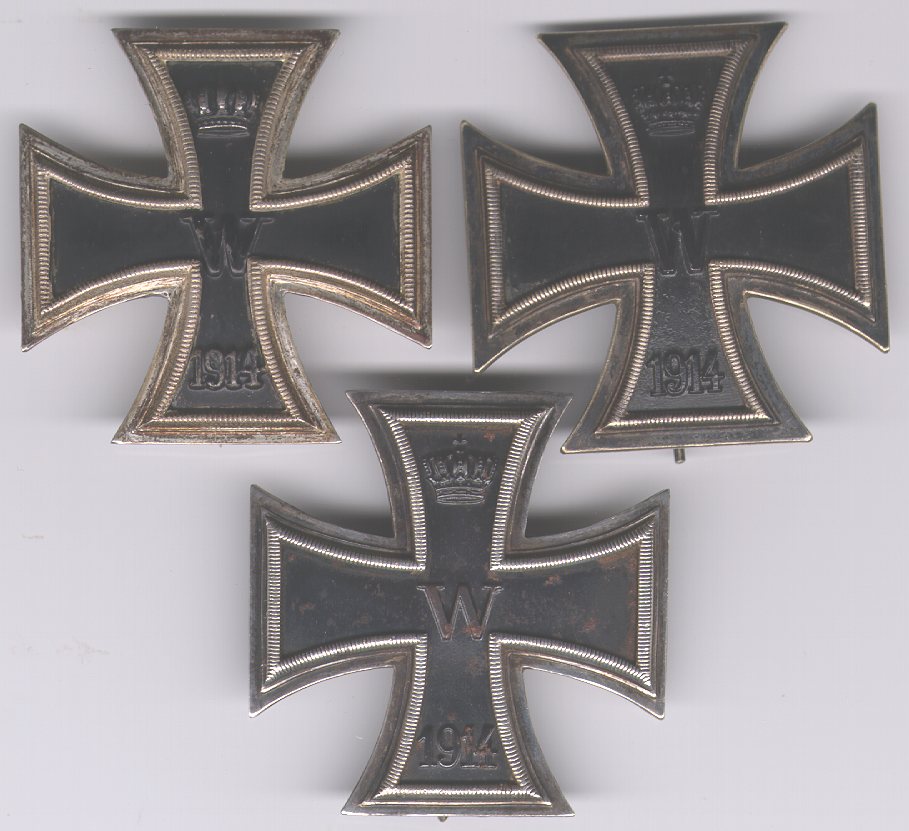
 0
0 -
-
Hi,
Love that enameled Meybauer at the top of the thread!
I've never managed to pick up a second class of this award - never found the one that was quite right for me.
My 4 examples are below. Intersting how the solid Meybauers always seem to have a GOLD/BRONZE finish to them - it seems to be more than a basemetal effect.
Regards
Mike
Obverse...
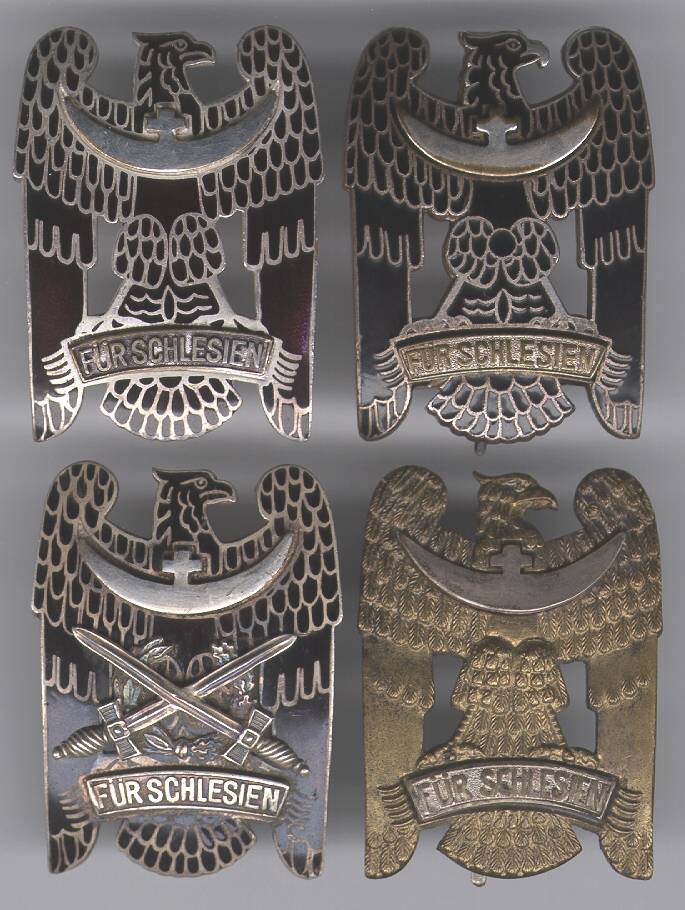
 0
0 -
Hi,
I'm late to this thread, but personally I do not get a good feeling from this cross. Round/Needle pin 1914 EK1s are actually quite uncommon. The widish barrel hinge and the pin with the flat spot at the hinge end instantly reminded me of of the hardware on the series EK1 equivalent repros that have recently hit the market (Meck-Schwerin, Oldenburg, Anhalt, Braunschweig, Meck-Strelitz). Further, imo the cross is not of good quality in either the beading or the core. The beading at the inner points is strange/unusual (almost childish in design) and the profile of the inner arms is more flat than curved. It is not one I would want in my collection.
Regards
Mike
0 -
I've seen the solid-back KM eagles with the "M"-in-a-diamond symbol attributed to KM insignia. As mentioned, unmarked hollow-backs like this one could be either KM or Heer General Officer.
Hi Scott,
Sounds like someone's been spinning yarns! The eagle may have been in a KM group but as far as I know the diamond M is only a maker mark (not sure for who), not a KM acceptance mark.
Paul, I think the Heer ones are actually slightly harder to find but I don't think there's much of a price difference.
Regards
Mike
0 -
Hi Nan Su,
Very nice example indeed. Very hard to find in any condition.
I've only managed to add a beaten up example with the important bit missing. Classic Juncker hinge and hand finishing though. I really like the enameling.
Regards
Mike
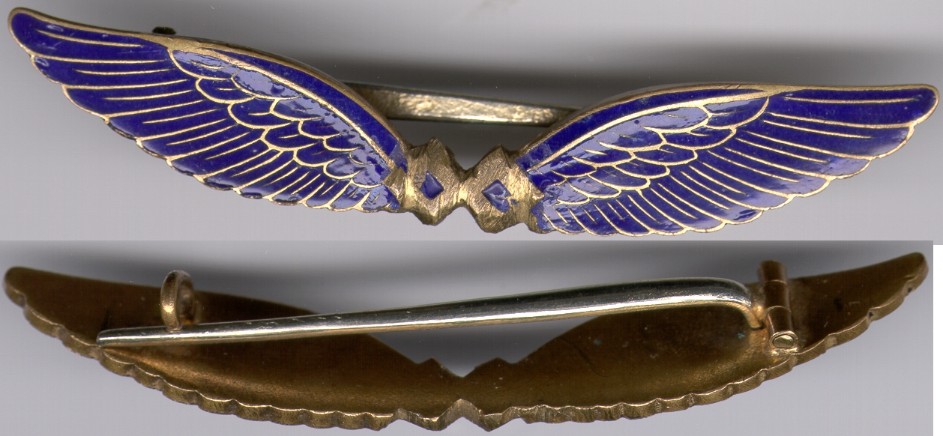
 0
0 -
Hi Paul,
I can only agree with Rick, no way to tell - unless it came from an estate. Same goes for KM Admin v's the standard Heer summer tunic eagle - both have a silver finish. Law of averages would suggest that a gold would be KM and silver would be Heer.
Regards
Mike
0 -
You don't need to have -original- dies to make copies of dies.
Les, yes that's true, but this case could be determined fairly easily. If Micha makes some detailed measurements then that should solve the issue. There's no way I can see that a set of dies made from an item will produce an item of the same size - shrinkage will occur at some stage in that sort of reproduction process.
Further, in this case we are talking about Deumer. We KNOW their dies survived the war and into the 50s and probably 60s as they were still a going concern with the earlier 57er EK1 variants (also flawed). It would turn into another case like the wartime S&L 39 RK dies.
Regards
Mike
0 -
SNAP!
Great comparison pics Micha.
Someone's been playing with original dies.
regards
Mike
0 -
...but every time I see one of these 'fat' and very distinctive crowns such as the one posted first, someone pipes up and claims 20's or 30's production...
Hi Marshall,
Just curious as to where you are heading. Do you think there is a problem with the fat crowns in general or the interpretation of their dating?
I agree that there seem to be a lot of this type on eBay recently. Many have very believable pre-45 hardware however imo some look like they have been created specifically for EK variant collectors (either out and out fakes or altered originals).
One thing to keep in mind is that this "fat" crown was the sytle that dominanted in Third Reich times (plenty of genuine LDO marked examples, some slight variations as well) and into the 50s (and probably 60s) as evidenced by earlier 1914 type "57ers".
All the fat crown crosses that I've been able to examine have been larger (43+ mm) crosses, commonly 44 mm crosses. If fakers have gotten hold of genuine dies, it is more likely they would be of this later and larger type (for both core and frames) as earlier dies are more likely to have been thrown out/destroyed.
Regards
Mike
0 -
Hi Micha,
Deumer was mentioned earlier and it actually may not be a bad call, in that the bad flaws on the frames of this (imo) repro are similar to 1939 and early 1957 Deumers - same with the beading. It's possible someone has got hold of some badly damaged original dies (not necessarily Imperial) and is starting to pump out repros. Out of curiosity, if the cross is in your posession, what are it's dimensions?
Regards
Mike
0 -
Hi Micha,
That reverse image explains why I didn't like the obverse image!
Imo no chance it is genuine. This is an example meant to fleece someone of serious money. I think the silver stamp combined with the obviously NON-SILVER frames is enough to kill this one for me. Even assuming the markings are a later add-on, I would find it very unusual that a normally high-quality modification was made to such a poor quality cross.
Pretty sure I've seen (and passed straight by) similar on xBay.
Regards
Mike
0 -
Hi Haynau,
Great image of a marking I've certainly never seen before. Thanks for going to the effort, it was very worthwhile imo. I'd certainly agree with Joe that your marking it totally unrelated to my "flying A"!
I'm putting out some feelers with some Euro silver specialists to see if they can come up with anything. That little A to the left of the stylised marking (initially I though maybe a JHW monogram) may have some Austrian connotation. I'll report back if/when I hear more.
Paul, it's my feeling that any vaulting would have been done at an early stage of manufacture, most probably before assembly. If they were vaulted post assembly the hand filed edges would never line up and the cross would be more prone to splitting at the seams due to the stress induced by the vaulting. From what I've see, it's normally only the thinner pressed cores that are vaulted - not the earlier cast iron cores which are prone to cracking even on flat-backed examples!
Regards
Mike
0 -
Hi ,
I have a 1957 sewn on ribbon bar and a 1957 uniform which came from the same man and belong together , i can see the outline of the bar on the jacket .
Should i sew the ribbon bar back onto the jacket ?
Hi Grant,
Personally I wouldn't have a problem with the proposed "repair" in this case. I'd be interested at your guess as to why the ribbon bar was removed in the first place! I hope you can source the same type of thread (I assume there are thread remnants on the ribbon bar) and that when you went to sell it you would tell the prospective new owner the history.
Regards
Mike
0 -
I presume the larger set has a 16mm RK and two 12mm EK's and the smaller one a 12mm RK and two 9mm EK's.
Hi Peter,
Actually they are a bit smaller - ~11&9 mm for the top one and ~9&7 mm for the bottom mini. Should have put a scale on I suppose.
Nice to see another maker marked 57er mini!!! I don't count S&L "circles" here (which I have on another stickpin), but I guess I should?
Re that unusual mini combo of 1914EK2 and 1939 Wound Badge, to me it looks earlier rather than a later example (is it zinc?) - the latter seem to have shinier and better lasting silver finishes.
Regards
Mike
0 -
Reverses...

 0
0 -
Hi,
Something that you don't see all that often, a couple of early RK/EK1/EK2 stickpins.
The top (larger) one is from an Oakleaves winner's estate (don't ask me why there aren't oaks on the RK!!). The EK1/EK2 were struck as a pair and are the same size as the RK on the other stickpin.
The smaller one (no provenance) comprises 3 separate pieces and, most interestingly, the round attachment device is maker marked for "Hoffstatter, Bonn" - first time I have seen a maker marked 57er stickpin.
Regards
Mike
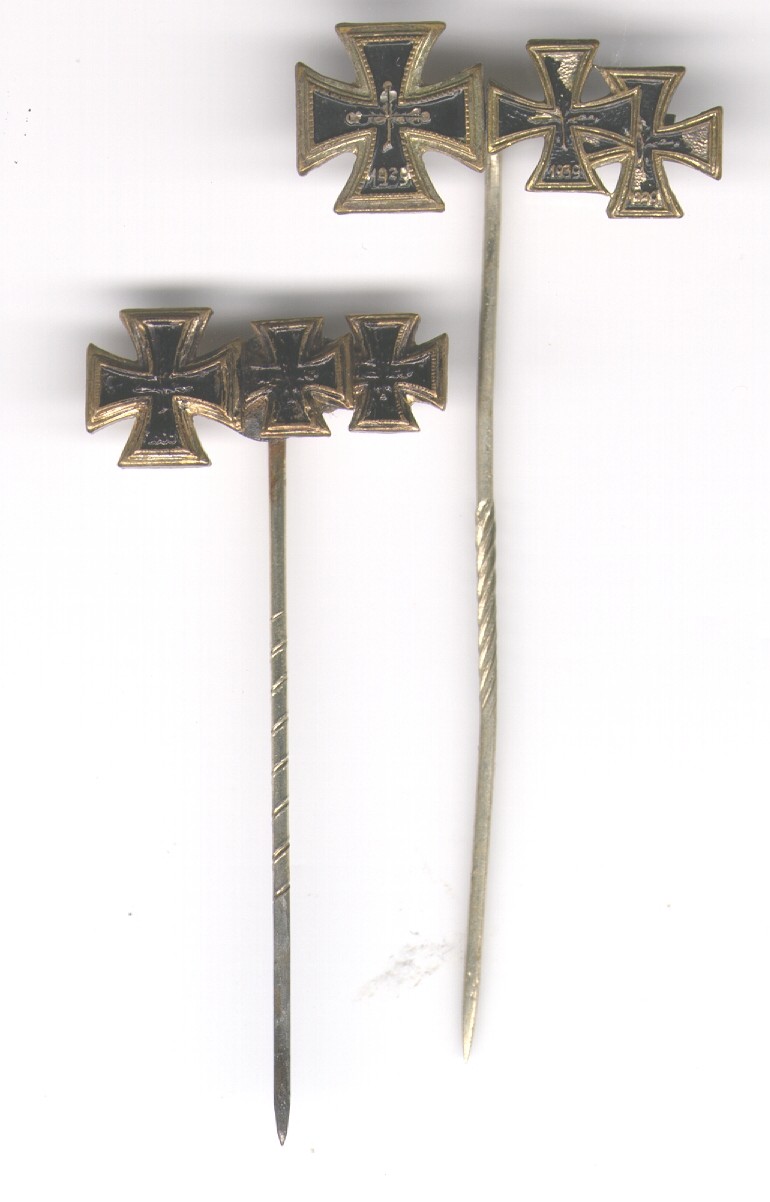
 0
0 -
Hi Haynau,
I have not see the mark you describe but I have a "moving" "A" (looks like a beck-to-front E joined to an A to form a monogram) on an "FR" flat-back 1914EK1.
Some straight-on obverse and reverse images would be great - have a go with the mark as well if you could please!
Regards
Mike
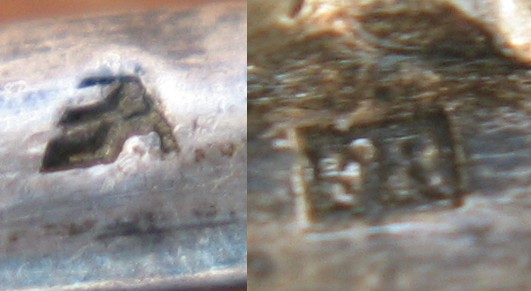
 0
0 -
Hi ekhunter,
Yes, they are the ones referred to. One is pinback, one is screwback. No reverses. I have no idea if they are genuine R&Ns or not, only that they appear to share the same core but imo different have a different core to Dan's example.
I agree, with all the online experience out there and there is still no definitely id'd R&N! Don't know how many times I've seen a Meybauer called and R&N as well, but only recently on another forum saw an AWS called a R&N (hopefully moderator Micha has corrected that one now!).
I also agree, Dan has a great cross - I'd add it to my collection in a heartbeat!
Regards
Mike
0 -
Hi,
The second ribbon looks like a faded Meck-Schwerin KVK2 - the center would have been blue initially.
Regards
Mike
0 -
Hi ekh,
You are correct imo, the Prinzen on P196 is a Meybauer. Micha was talking about the twin cased examples on P201 though. Imo it is clear enough that they are NOT the same as Dan's example - the "4" on Dan's example is unique for me so far, with the top of the 4 very open and the vertical arm almost straight. Both of the "4" on the Previtera book exampels are more typical of EKs with only a slight separation at the top of the "4".
One more question regarding the silver marks. As far as I know, Austria used a number system inside the Dianakopf (1 = 950/1000, 2 = 900/1000, 3 = 800/1000, 4 = 750/1000), so why is there a German style "900" stamp on the pin??
For Rick, Budapest was a P (for Pest) between 1967 and 1872.
Regards
Mike
0 -
Hi Jan Arne,
Imo the second cross is definitely L/13 - the lower part of the 3 is simply not formed. Further, that other mark is imo actually a "7" - typically weakly formed on 1939 Meybauer EK1s. I don't think I've seen the double Lieferant/LdO marking on a Meybauer before! Nice one.
Regards
Mike
0


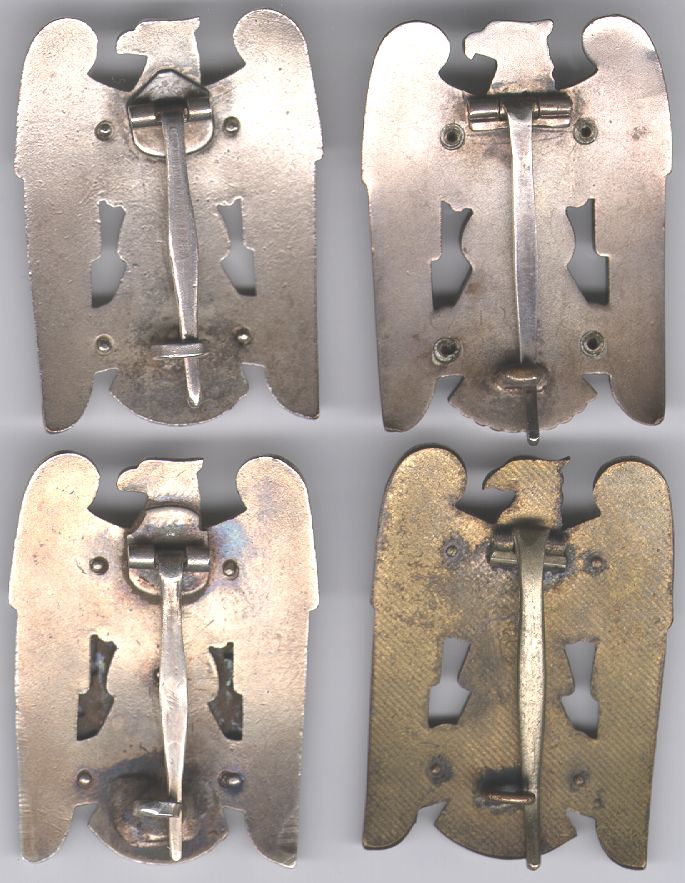
Some ribbon bar medal IDs please....
in Germany: Imperial: The Orders, Decorations and Medals of The Imperial German States
Posted
Hi,
I can't think what the 2nd ribbon on the top bar might be - light-medium blue with two white (not silver) stripes near the edges. The 3rd ribbon on the top bar (yellow/gold with three dark blue strikes) is Schwarzburg, correct?
On the 7 place bar, what might the 3 blue ribbons represent? I'm guessing the first one might be a KO and the second a LS but I'm not sure about the one that appears to have had a device.
Any/all help appreciated!
Regards
Mike
Obverse...